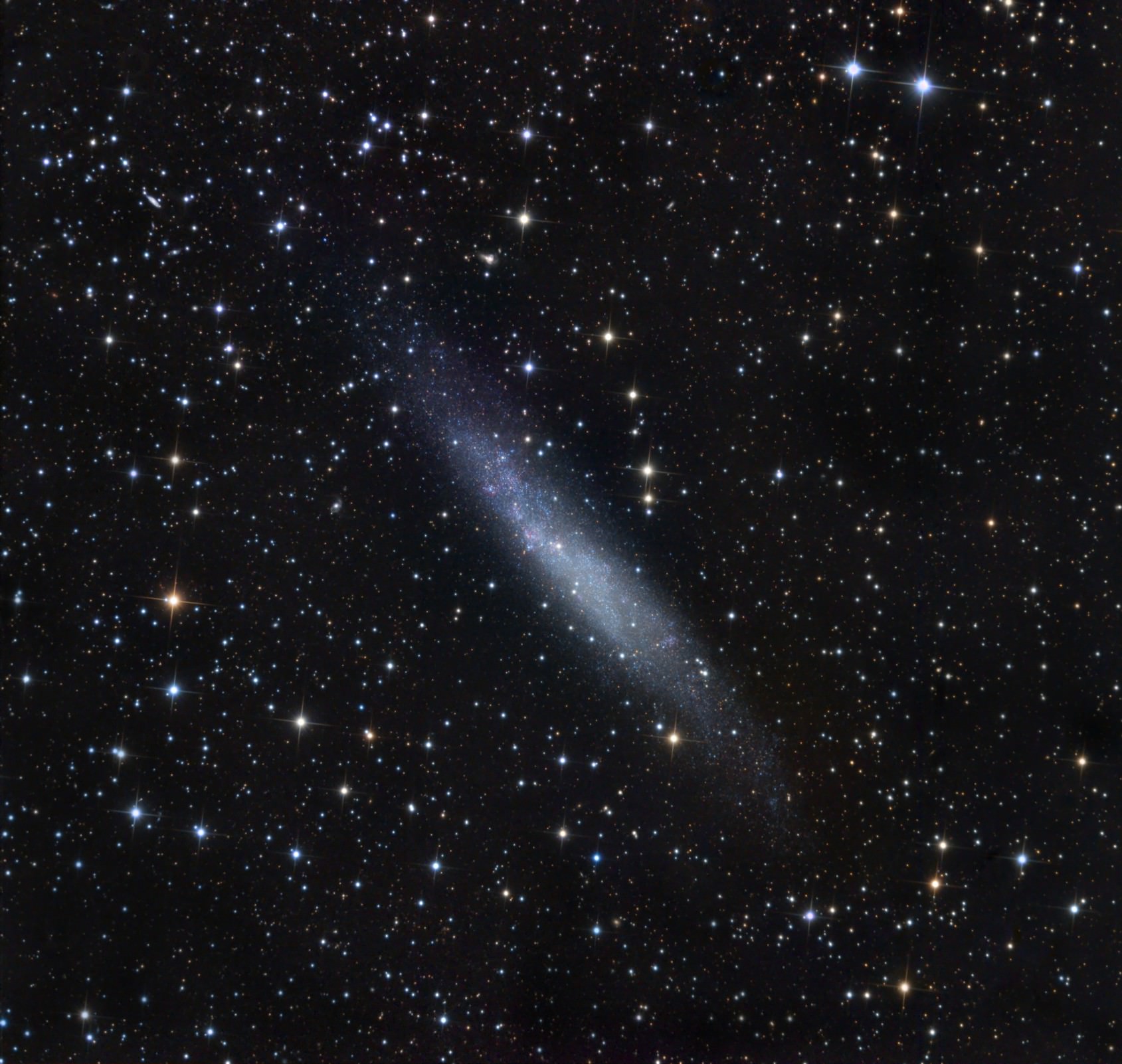

NGC 3109 by Ken Crawford
[/caption]
Somewhere off in the far reaches of Hydra about 4.3 million light years away is a local subgroup of galaxies and a small, barred spiral that just seems to be quietly minding its own business. Or is it? NGC 3109 might not look like much at first, but this little island universe is really turning the tides…
First discovered by John Herschel on March 24, 1835 while in South Africa, NGC 3109 was first classed as an irregular galaxy – the dominating member of a small group of dwarf galaxies believed to be Local Group Member candidates – a determination which isn’t easy to make. “The Local Group dwarf galaxies offer a unique window to the detailed properties of the most common type of galaxy in the Universe.” says Mario L. Mateo, “Our understanding of these galaxies has grown impressively in the past decade, but fundamental puzzles remain that will keep the Local Group at the forefront of galaxy evolution studies for some time.”
What makes NGC 3109 and its little band of followers so interesting? Well, chances are it may not be a member of our Local Group at all, but the nearest of the outsiders. “The small Antlia-Sextans clustering of galaxies is located at a distance of only 1.36 Mpc from the Sun and 1.72 Mpc from the adopted barycenter of the Local Group. The latter value is significantly greater than the radius of the zero-velocity surface of the Local Group that, for an assumed age of 14 Gyr, has R_0=1.18+/-0.15 Mpc.” says Sidney Van den Bergh, “This, together with the observation that the members of the Ant-Sex group have a mean redshift of 114+/-12 km s^-1 relative to the centroid of the Local Group, suggests that the Antlia-Sextans group is not bound to our Local Group and that it is expanding with the Hubble flow. If this conclusion is correct, then Antlia-Sextans may be the nearest external clustering of galaxies.”
So, if NGC 3109 can hold those kind of secrets… What other kinds of secrets can it keep to itself? Try a tiny tidally interacting elliptical galaxy discovered in 1999 by Alan Whiting, George Hau and Mike Irwin. It’s called the Antlia dwarf and it was found to be just beyond the zero-velocity surface of the Local Group. “These data increase the number of certain (or probable) Local Group members to 36. The spatial distribution of these galaxies supports Hubble’s claim that the Local Group “is isolated in the general field.” Currently available evidence suggests that star formation continued much longer in many dwarf spheroidals than it did in the main body of the Galactic halo.” says Sidney Van den Bergh, “It is suggested that “young” globular clusters, such as Ruprecht 106, might have formed in now defunct dwarf spheroidals. Assuming SagDIG, which is the most remote Local Group galaxy, to lie on, or just inside, the zero-velocity surface of the Local Group yields a dynamical age >~17.9+/-2.7 Gyr. However, this value is meaningful only if the outer regions of the local Group are in virial equilibrium.”
Take a look at the full-size image done by Ken Crawford and check out all the red and blue super giant stars and scattered HII regions where new stars are forming – along with all the background galaxies. According to the work of D.G. Barnes; “A substantial warp in the disk of NGC 3109 is detected in the H I emission image in the form of an extended low surface brightness feature. We report a positive detection in H I of the nearby Antlia dwarf galaxy and measure its total neutral gas mass to be 6.8+/-1.4×105 M solar. We show the warp in NGC 3109 to lie at exactly the same radial velocity as the gas in the Antlia dwarf galaxy and speculate that Antlia disturbed the disk of NGC 3109 during a mild encounter ~1 Gyr in the past. H I data for a further eight galaxies detected in the background are presented.”
In the meantime, NGC 3109 continues to be an on-going object of study. Its many compact HII regions could be an indicator of planetary nebulae formations that are totally unlike anything we’ve seen before. “The excitation patterns of the PNe in NGC 3109 are very different from the excitation patterns of PNe in other galaxies.” says Miriam Pena, “This would imply that the evolution of PNe depends upon the properties of their progenitor stellar populations, which vary from galaxy to galaxy. This should affect the PN luminosity function and its use as a distance indicator.” And NGC 3109’s unique structure has equally fascinated Sebastian Hidalgo; “Its edge-on orientation (which simplifies the study of a possible halo) and the possibility that it could, in fact, be a small spiral (the smallest in the Local Group) makes its deep analysis of major relevance to understand the properties of dwarf galaxies and the transition from dwarf irregulars to spirals.”
Many thanks to Ken Crawford for this inspiring image!
Some exoplanets have characteristics totally alien to our Solar System. Hot Jupiters are one such…
Stars form in Giant Molecular Clouds (GMCs), vast clouds of mostly hydrogen that can span…
Let’s dive into one of those cosmic curiosities that's bound to blow your mind: how…
The majority of the universe remains unmapped, but we have a potential window into it…
NASA engineers are pressing ahead with preparations for the Artemis II mission unless someone tells…
It’s not uncommon for space missions to be tested here on planet Earth. With the…